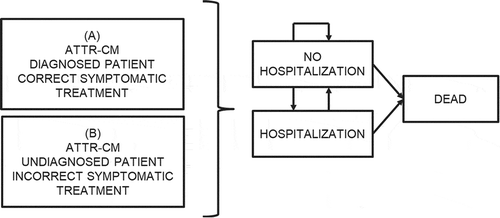Figures & data
Figure 1. Markov model. Analysis: A vs B

Table 1. Markov model probabilities
Table 2. Economic model costs (€ 2019)
Table 3. Estimated reduction in mortality with and without diagnosis of ATTR-CM
Figure 2. Life-years gained by a patient diagnosed with ATTR-CM receiving correct symptomatic treatment compared to the undiagnosed patient

Figure 3. Cardiovascular-related hospitalizations avoided with and without ATTR-CM diagnosis. ATTR-CM: Transthyretin amyloid cardiomyopathy

Table 4. Costs and savings generated per patient diagnosed with ATTR-CM who receives correct symptomatic treatment, compared to the undiagnosed patient. Detailed results
